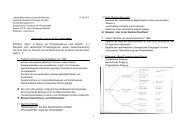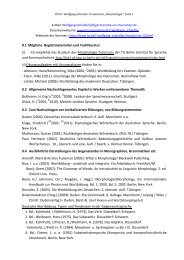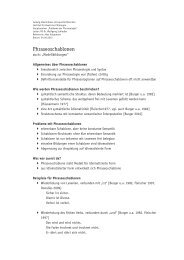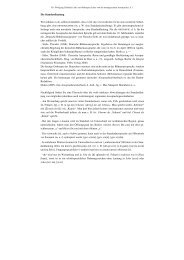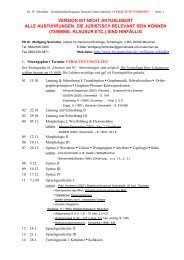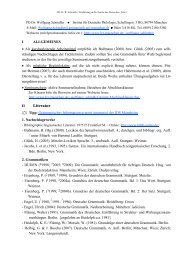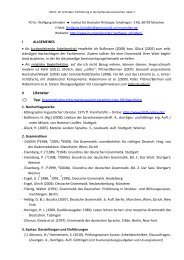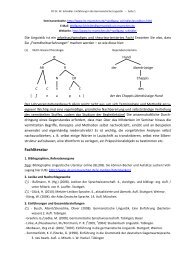Chapter 18 Lexical Functions: Description of Lexical Relations in a ...
Chapter 18 Lexical Functions: Description of Lexical Relations in a ...
Chapter 18 Lexical Functions: Description of Lexical Relations in a ...
Create successful ePaper yourself
Turn your PDF publications into a flip-book with our unique Google optimized e-Paper software.
—<strong>Chapter</strong> <strong>18</strong>. <strong>Lexical</strong> <strong>Functions</strong>— 3<br />
• The LUs <strong>of</strong> the second type are different <strong>in</strong> this respect. The selection <strong>of</strong> such an LU is<br />
cont<strong>in</strong>gent upon other lexical choices—such that its own mean<strong>in</strong>g can be more or less disregarded<br />
<strong>in</strong> the search and selection process. These are restricted LUs. The Speaker looks for a<br />
restricted LU (<strong>in</strong> his lexical stock) based on some other LUs he has already chosen. These<br />
lexically-driven restricted lexical choices are carried out along the two major l<strong>in</strong>guistic axes:<br />
paradigmatic and syntagmatic.<br />
On the one hand, the Speaker, while speak<strong>in</strong>g <strong>of</strong> cars, may need to f<strong>in</strong>d the name for a<br />
(small bus<strong>in</strong>ess which sells gas and oil for automobiles ...) [= GAS STATION] or for a (little plaque<br />
which is designed to be fixed on a vehicle and on which the vehicle’s registration number is<br />
pr<strong>in</strong>ted) [= LICENSE PLATE]; this is a paradigmatic choice, and the correspond<strong>in</strong>g search is<br />
done start<strong>in</strong>g with CAR, AUTOMOBILE or VEHICLE, which must have po<strong>in</strong>ters to GAS STATION<br />
and LICENSE PLATE. On the other hand, the Speaker may need to f<strong>in</strong>d the name for an event or a<br />
property <strong>in</strong>volv<strong>in</strong>g a car, e.g., when (the wheels <strong>of</strong> a car lose their grip on the road, so that the car<br />
slides sideways) [= The car SKIDS] or to say that his (car uses up too much gasol<strong>in</strong>e) [= This car is<br />
a GAS-GUZZLER]; this is a syntagmatic choice, the search for the necessary LU also be<strong>in</strong>g<br />
conducted under the control <strong>of</strong> the LU CAR. Underly<strong>in</strong>g both types <strong>of</strong> lexical choices are relations<br />
that l<strong>in</strong>k LUs <strong>in</strong> a lexicon: <strong>in</strong> both cases what the Speaker needs are lexical correlates <strong>of</strong><br />
the start<strong>in</strong>g LU he has <strong>in</strong> m<strong>in</strong>d.<br />
<strong>Lexical</strong> <strong>Functions</strong> [= LFs], the object <strong>of</strong> this chapter, are a set <strong>of</strong> formal tools designed to<br />
describe, <strong>in</strong> a systematic and compact way, all types <strong>of</strong> genu<strong>in</strong>e lexical relations 1 that<br />
hold between LUs <strong>of</strong> any language. This amounts to specify<strong>in</strong>g, for any given LU, all the lexical<br />
correlates that might be needed <strong>in</strong> the process <strong>of</strong> speak<strong>in</strong>g. LFs are also extremely convenient for<br />
paraphras<strong>in</strong>g on the DSynt-level—a topic that is covered <strong>in</strong> Part IV, <strong>Chapter</strong> 14, p. 00ff.<br />
<strong>Lexical</strong> <strong>Functions</strong> were first <strong>in</strong>troduced <strong>in</strong> 1965 (Žolkovskij & Mel´čuk 1965, 1966 and<br />
1967). 2 They are aimed at describ<strong>in</strong>g ‘<strong>in</strong> parallel’ both <strong>of</strong> the two above-mentioned types <strong>of</strong><br />
lexical correlates, that is, the paradigmatic and the syntagmatic choices <strong>of</strong> LUs which depend on<br />
previously made lexical choices. These types have mostly been considered separately <strong>in</strong><br />
l<strong>in</strong>guistics, but turn out to be <strong>of</strong> the same logical nature: both are readily amenable to a<br />
description via the concept <strong>of</strong> function <strong>in</strong> the mathematical sense. Thus, for an LU L, the LFs<br />
cover both types <strong>of</strong> lexical correlates: 1) paradigmatic lexical correlates, or semantic<br />
derivations <strong>of</strong> L; and 2) syntagmatic lexical correlates <strong>of</strong> L, or collocates <strong>of</strong> L, which<br />
form collocations with L.


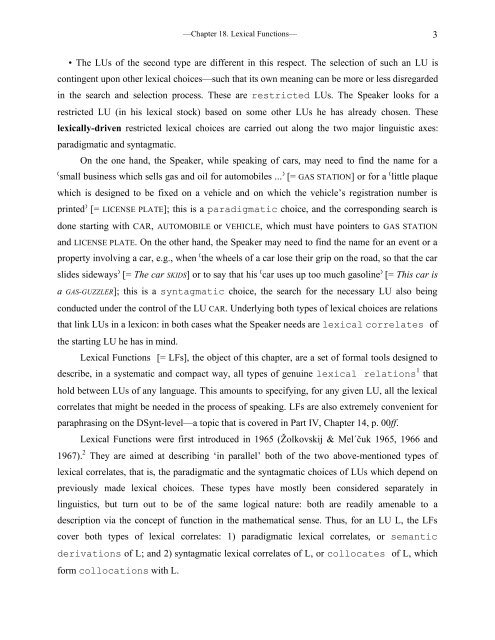
![E-Mail: Wolfgang.Schindler[ätt]germanistik.uni-muenchen.de Web ...](https://img.yumpu.com/51590147/1/184x260/e-mail-wolfgangschindlerattgermanistikuni-muenchende-web-.jpg?quality=85)
